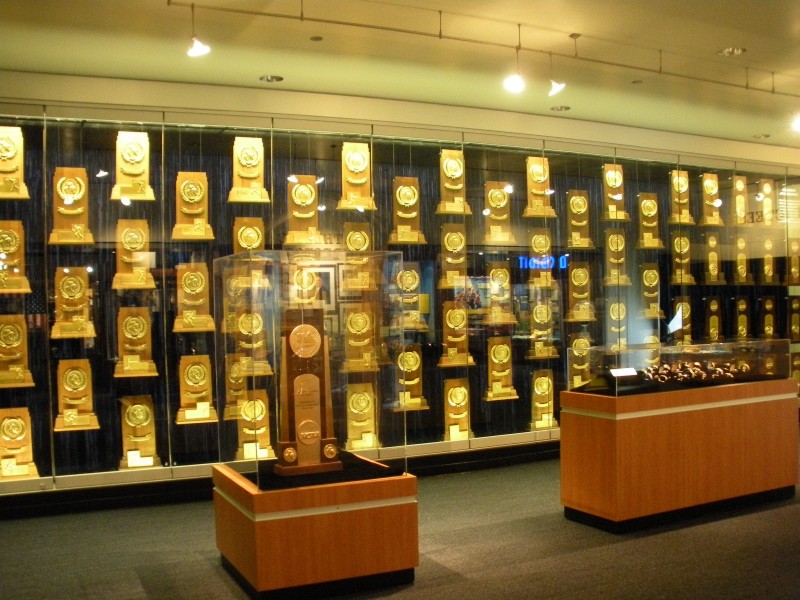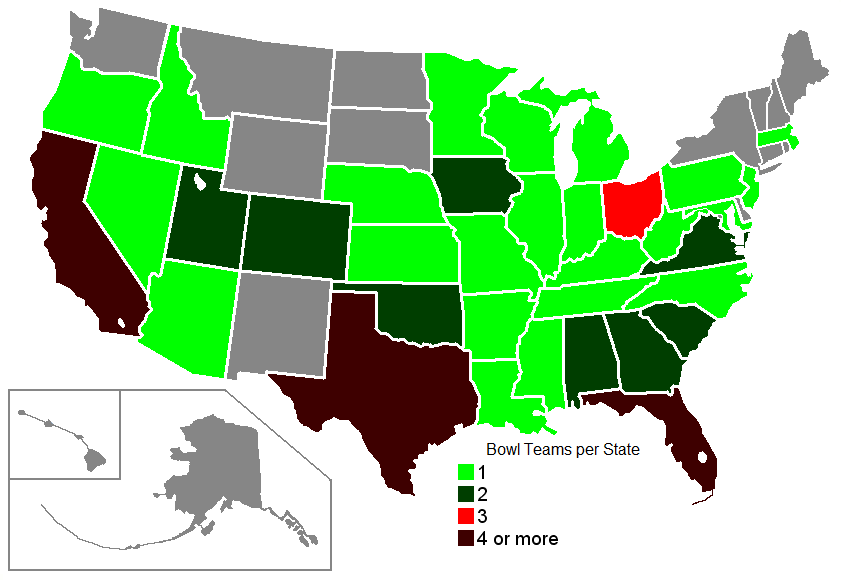|
Bowl Challenge Cup
The Bowl Challenge Cup is a competition among NCAA college football conferences in the Football Bowl Subdivision, formerly called Division I-A, based on win–loss records in the bowl games that take place annually during December and January. The winner is the conference that has the highest winning percentage, among conferences with a minimum of three teams appearing in bowl games. The Challenge was created in 2002 by ESPN, who also occasionally refers to it as the "Bowl Cup Challenge" when promoting it. Originally sponsored by Cooper Tire, ESPN went several years without a sponsor; since the 2015–16 bowl season, Progressive has been the sponsor. Participants The ten Football Bowl Subdivision (formerly Division I-A) conferences that compete in the Bowl Challenge Cup are: Power Five * Atlantic Coast Conference * Big Ten Conference * Big 12 Conference * Pac-12 Conference * Southeastern Conference Group of Five * American Athletic Conference * Conference USA * Mid-American Con ... [...More Info...] [...Related Items...] OR: [Wikipedia] [Google] [Baidu] |
2015–16 NCAA Football Bowl Games
The 2015–16 NCAA football bowl games were a series of college football bowl games. They completed the 2015 NCAA Division I FBS football season. The games began on December 19, 2015 and, aside from the all-star games, ended with the 2016 College Football Playoff National Championship which was played on January 11, 2016. A new record total of 41 team-competitive bowl games were played in FBS, including the national championship game and the inaugural Cure Bowl and Arizona Bowl. While bowl games had been the purview of only the very best teams for nearly a century, this was the tenth consecutive year that teams with non-winning seasons were bowl-eligible and participated in bowl games. To fill the 80 available team-competitive bowl slots, a new record 15 teams (19% of all participants) with non-winning seasons participated in bowl games—12 had a .500 (6–6) season and, for another new record, three had a sub-.500 season. Those three teams each had 5–7 seasons, sharing a new re ... [...More Info...] [...Related Items...] OR: [Wikipedia] [Google] [Baidu] |
Pac-12 Conference
The Pac-12 Conference is a collegiate List of NCAA conferences, athletic conference, that operates in the Western United States, participating in 24 sports at the NCAA Division I level. Its College football, football teams compete in the NCAA Division I Football Bowl Subdivision, Football Bowl Subdivision (FBS; formerly Division I-A), the highest level of college football in the nation. The conference's 12 members are located in the states of Arizona, California, Colorado, Oregon, Utah, and Washington (state), Washington. They include each state's flagship public university, four additional public universities, and two private research universities. The modern Pac-12 conference formed after the disbanding of the Pacific Coast Conference (PCC), whose principal members founded the Athletic Association of Western Universities (AAWU) in 1959. The conference previously went by the names Big Five, Big Six, Pacific-8, and Pacific-10. The Pac-12 moniker was adopted in 2011 with the add ... [...More Info...] [...Related Items...] OR: [Wikipedia] [Google] [Baidu] |
2007–08 NCAA Football Bowl Games
The 2007–08 NCAA football bowl games concluded the 2007 NCAA Division I FBS regular season in college football. A total of 32 team-competitive plus four all-star postseason games were played. While bowl games had been the purview of only the very best teams for nearly a century, this was the second consecutive year that teams with non-winning seasons participated in bowl games. To fill the 64 available bowl slots from the 119 schools in the Bowl Subdivision, a total of seven teams (11% of all participants) with non-winning seasons participated in bowl games—all seven had a .500 (6-6) season. Selection of the teams For the 2007–08 season, NCAA bylaws stipulated that any team that finished with at least a 6-6 overall regular season record can only be selected to fill a conference tie-in bowl slot once all other available conference teams are chosen. The Big Ten had ten teams who finished with a 6-6 or better regular season record, but only were allocated six slots not i ... [...More Info...] [...Related Items...] OR: [Wikipedia] [Google] [Baidu] |
2006–07 NCAA Football Bowl Games
The 2006–07 NCAA football bowl games concluded the 2006 NCAA Division I FBS football season in college football. A record of 32 team-competitive plus five all-star postseason games were played, with the addition of the new stand-alone Bowl Championship Series National Championship Game, the International Bowl in Toronto, Ontario (the first all-USA bowl game played outside the country since the 1937 Bacardi Bowl in Cuba), the Papajohns.com Bowl, the New Mexico Bowl, and the post-season-ending all-star Texas vs. The Nation Game. To fill the 64 available bowl slots from the 119 schools in the Bowl Subdivision, a record 7 teams (11% of all participants) with non-winning seasons participated in bowl games—all seven had a .500 (6-6) season. Along with the increase in bowl games, the NCAA ruled that teams could schedule twelve regular-season games (up from eleven) beginning in the 2006 season. NCAA teams in Alaska and Hawaii, and their home opponents, are allowed to schedule an ... [...More Info...] [...Related Items...] OR: [Wikipedia] [Google] [Baidu] |
2005–06 NCAA Football Bowl Games
The 2005–06 NCAA football bowl games were a series of 28 post-season games (including the Bowl Championship Series) that was played in December 2005 and January 2006 for Division I-A football teams and all-stars from Divisions I-AA, II, and III, as well as from the NAIA. The post-season began with the New Orleans Bowl on December 20, 2005, and concluded with the Senior Bowl, played on January 28, 2006. For the second consecutive year, the 28 team-competitive bowl games were played by 56 teams with winning records, as no teams with non-winning seasons (6–6, or .500) were invited to participate in bowl games. Schedule Non-BCS bowls With 64 teams having winning records, and 56 slots in bowl games, there were more teams than slots available for teams to get a bowl bid. Again, as in 2004, two conferences — the Pac 10 and the SEC — did not have enough teams to fill the required number of slots for their non-BCS bowls. A third conference — the Big Ten — had two teams ... [...More Info...] [...Related Items...] OR: [Wikipedia] [Google] [Baidu] |
2004–05 NCAA Football Bowl Games
The 2004–05 NCAA football bowl games were a series of 32 post-season games (including the Bowl Championship Series) played in December 2004 and January 2005 for Division I-A football teams and their all-stars. The post-season began with the New Orleans Bowl on December 14, 2004, and concluded on January 29, 2005, with the season-ending Senior Bowl. A total of 28 team-competitive games, and five all-star games, were played. For the first time in three years, the 56 available bowl slots were filled by teams with winning records, as no teams with non-winning seasons (6–6, or .500) were invited to participate in bowl games. Schedule Non-BCS bowls Of the 59 Division I-A football teams with winning records, 56 were invited to the various bowl games. This season, bowl officials had more difficulty than usual filling their slots. Because the regular season was only 11 games, teams had to finish at least 6–5 to qualify. Teams that were allowed under NCAA rules to play a 12th regul ... [...More Info...] [...Related Items...] OR: [Wikipedia] [Google] [Baidu] |
2003–04 NCAA Football Bowl Games
The 2003–04 NCAA football bowl games were a series of 28 post-season games (including the Bowl Championship Series) played in December 2003 and January 2004 for Division I-A football teams and their all-stars. The post-season began with the New Orleans Bowl on December 16, 2003, and concluded on January 31, 2004, with the season-ending Gridiron Classic. A total of 28 team-competitive games, and two all-star games, were played. To fill the 56 available bowl slots, four teams with non-winning seasons participated in bowl games—all four had a .500 (6–6) season. While teams that did not have winning seasons were invited to bowl games, seven teams with winning records were left out: Northern Illinois (10–2); Connecticut (9-3); Marshall and Toledo (both 8–4); Air Force and Akron (both 7–5); and South Florida (7–4). Poll rankings The below table lists top teams (per polls taken after the completion of the regular season and any conference championship games), their w ... [...More Info...] [...Related Items...] OR: [Wikipedia] [Google] [Baidu] |
2002–03 NCAA Football Bowl Games
The 2002–03 NCAA football bowl games were a series of 28 post-season games (including the Bowl Championship Series) played in December 2002 and January 2003 for Division I-A football teams and their all-stars. The post-season began with the New Orleans Bowl on December 17, 2002, and concluded on February 1, 2003, with the season-ending Hula Bowl. A new record of 28 team-competitive bowls, and two all-star games, were played, including the inaugural Continental Tire Bowl, Hawaii Bowl and San Francisco Bowl. To fill the 56 available team-competitive bowl slots, a total of three teams with non-winning seasons participated in bowl games—all three had a .500 (6–6) season. Poll rankings The below table lists top teams (per polls taken after the completion of the regular season and any conference championship games), their win–loss records (prior to bowl games), and the bowls they later played in. The AP column represents rankings per the AP Poll, while the BCS column represen ... [...More Info...] [...Related Items...] OR: [Wikipedia] [Google] [Baidu] |
Western Athletic Conference
The Western Athletic Conference (WAC) is an NCAA Division I conference. The WAC covers a broad expanse of the western United States with member institutions located in Arizona, California, New Mexico, Utah, Washington (state), Washington, and Texas. Due to most of the conference's College football, football-playing members leaving the WAC for other affiliations, the conference discontinued football as a sponsored sport after the 2012–13 season and left the NCAA's NCAA Division I Football Bowl Subdivision, Football Bowl Subdivision (formerly known as Division I-A). The WAC thus became the first Division I conference to drop football since the Big West Conference, Big West in 2000. The WAC then added men's soccer and became one of the NCAA's eleven Division I non-football conferences. The WAC underwent a major expansion on July 1, 2021, with four schools joining. The conference reinstated football at that time and now competes in the NCAA Division I Football Championship Subdivisio ... [...More Info...] [...Related Items...] OR: [Wikipedia] [Google] [Baidu] |
Big East Conference (1979–2013)
The Big East Conference was a collegiate athletics conference that consisted of as many as 16 universities in the eastern half of the United States from 1979 to 2013. The conference's members participated in 24 NCAA sports. The conference had a history of success at the national level in basketball throughout its history, while its shorter (1991 to 2013) football program, created by inviting one college and four other "associate members" (their football programs only) into the conference, resulted in two national championships. In basketball, Big East teams made 18 Final Four appearances and won 7 NCAA championships as Big East members through 2013 (UConn with three, Georgetown, Syracuse, Louisville and Villanova with one each). Of the Big East's full members, all but South Florida attended the Final Four, the most of any conference, though Marquette, DePaul, Notre Dame, Rutgers, Cincinnati, and Pittsburgh made all their trips before joining the Big East. In 2011, the Big East ... [...More Info...] [...Related Items...] OR: [Wikipedia] [Google] [Baidu] |
Sun Belt Conference
The Sun Belt Conference (SBC) is a collegiate athletic conference that has been affiliated with the NCAA's Division I since 1976. Originally a non-football conference, the Sun Belt began sponsoring football in 2001. Its football teams participate in the Division I Football Bowl Subdivision (FBS). The 14 member institutions of the Sun Belt are distributed primarily across the southern United States. History The Sun Belt Conference was founded on August 4, 1976, with the University of New Orleans, the University of South Alabama, Georgia State University, Jacksonville University, the University of North Carolina at Charlotte, and the University of South Florida. Over the next ten years the conference would add Western Kentucky University, Old Dominion University, the University of Alabama at Birmingham, and Virginia Commonwealth University. New Orleans was forced out of the league in 1980 due to its small on-campus gymnasium that the conference did not deem suitable for conferen ... [...More Info...] [...Related Items...] OR: [Wikipedia] [Google] [Baidu] |
Conference USA
Conference USA (C-USA or CUSA) is an intercollegiate athletic conference whose current member institutions are located within the Southern United States. The conference participates in the NCAA's Division I in all sports. C-USA's offices are located in Dallas, Texas. History C-USA was founded in 1995 by the merger of the Metro Conference and Great Midwest Conference, two Division I conferences that did not sponsor football. However, the merger did not include either Great Midwest member Dayton or Metro members VCU and Virginia Tech. Since this left an uneven number of schools in the conference, Houston of the dissolving Southwest Conference was extended an invitation and agreed to join following the SWC's disbanding at the end of the 1995–96 academic year. The conference immediately started competition in all sports, except football which started in 1996. Being the result of a merger, C-USA was originally a sprawling, large league that stretched from Florida to Missouri, ... [...More Info...] [...Related Items...] OR: [Wikipedia] [Google] [Baidu] |







